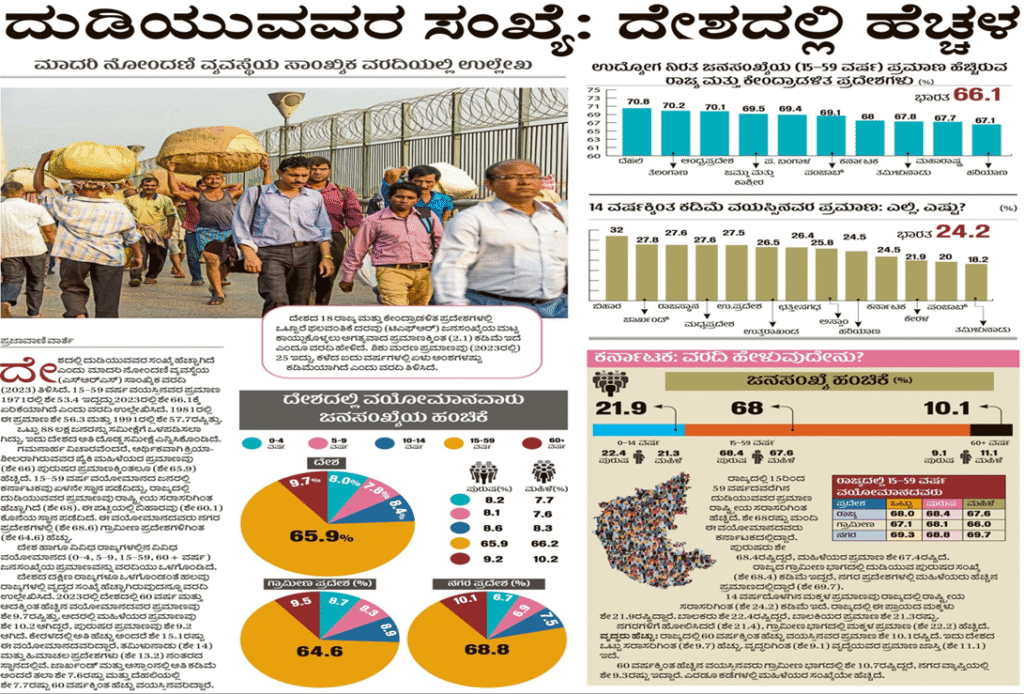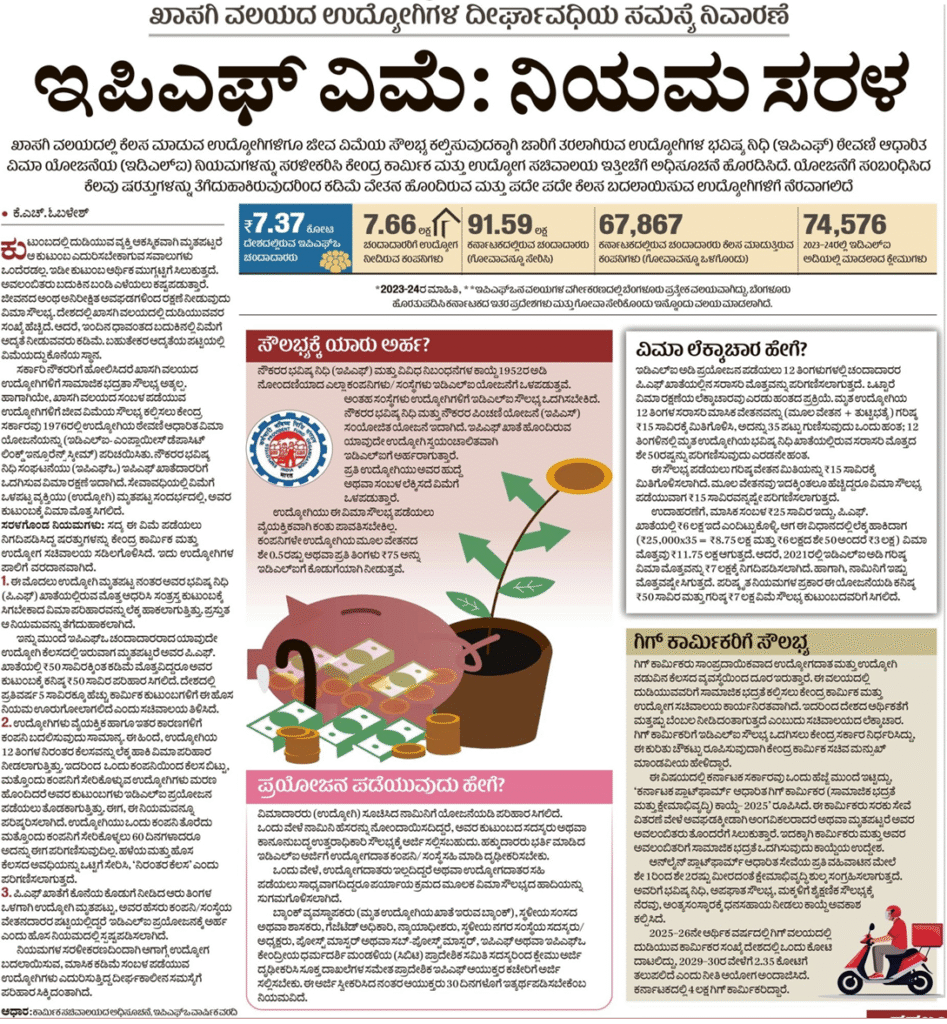ಪ್ರಚಲಿತ ವಿದ್ಯಮಾನಗಳು: 25ನೇ ಸೆಪ್ಟೆಂಬರ್ 2025
- ಭಿತ್ತಿ ಉಳಿಸಿ ದೂರ ಸರಿದರು
ಸಂದರ್ಭ: ಭೈರಪ್ಪನವರ ಜೊತೆಗೆ ಕನ್ನಡ ಸಾರಸ್ವತಲೋಕದ ಒಂದು ಮಹಾಧ್ಯಾಯ ಅಂತ್ಯ ಗೊಂಡಿದೆ. ಭೈರಪ್ಪ ಅವರು ತಮ್ಮ ಸುದೀರ್ಘ ಬದುಕಿನಲ್ಲಿ ಕನ್ನಡ ಸಾಹಿತ್ಯಲೋಕಕ್ಕೆ ಮತ್ತು ಸಹೃದಯರಿಗೆ ರಸಾನಂದದ ಜಲಪಾತವನ್ನೇ ಒದಗಿಸಿದ್ದಾರೆ.

- ‘ಪದ್ಮಭೂಷಣ’, ‘ಸರಸ್ವತಿ ಸಮ್ಮಾನ್’ ಪುರಸ್ಕೃತ ಕಾದಂಬರಿಕಾರ ಪ್ರೊ.ಎಸ್.ಎಲ್.ಭೈರಪ್ಪ (94).
- ಕೇವಲ ಕಾದಂಬರಿಗಳನ್ನು ರಚಿಸುತ್ತೇನೆ ಎಂದು ಭೀಷ್ಮನಿಷ್ಠೆಯಿಂದ ಸಂಕಲ್ಪ ಮಾಡಿ ಬರೆದವರು ಭೈರಪ್ಪನವರು. ಸಾಹಿತ್ಯಕೃಷಿಯ ಪ್ರಾರಂಭದ ಅವಧಿಯಲ್ಲಿ ಸಣ್ಣಕತೆಗಳನ್ನು ಬರೆದರಾದರೂ ನಂತರ ತಮ್ಮ ಶಕ್ತಿ ಮತ್ತು ವಿಸ್ತಾರ ದೃಷ್ಟಿಗೆ ಅನುಕೂಲವಾಗುವಂತಹ ಕಾದಂಬರಿಯ ಪ್ರಕಾರವನ್ನೇ ಅವರ ಅಭಿವ್ಯಕ್ತಿಗೆ ಆರಿಸಿಕೊಂಡರು.
- ತಾವು ಅಪಾರ ಪ್ರೀತಿ ಇಟ್ಟುಕೊಂಡಿದ್ದ ಹಿಂದೂಸ್ಥಾನಿ ಶೈಲಿಯ ಸಂಗೀತದಂತೆಯೇ ಮಾನವ ಸ್ವಭಾವದ ಹಲವು ಮಗ್ಗಲುಗಳನ್ನು ವಿಸ್ತಾರವಾಗಿ ಅನ್ವೇಷಿಸುವಂತಹ ರೀತಿಯಲ್ಲಿ ಕಾದಂಬರಿಗಳನ್ನು ರಚಿಸಿದರು. ಇವು ಭಾರತೀಯತೆಯ ಶ್ರುತಿಗೂ, ಜೀವನದ ಸತ್ಯ, ಶಿವ, ಸೌಂದರ್ಯಗಳ ಲಯಸಂಚಾರಕ್ಕೂ ಬದ್ಧವಾಗಿವೆ.
- ಕತಾರ್ನಲ್ಲಿ ಯುಪಿಐ ಸೇವೆ
ಸಂದರ್ಭ: ಕ್ಯೂಆರ್ ಕೋಡ್ ಆಧಾರಿತ ಯುಪಿಐ ಪಾವತಿ ವ್ಯವಸ್ಥೆ ಯನ್ನು ಕತಾರ್ನ ಆದ್ಯಂತ ಬಳಕೆಗೆ ಲಭ್ಯವಾಗಿಸಲಾಗಿದೆ ಎಂದು ಎನ್ಪಿಸಿಐ ಹೇಳಿದೆ.
- ಭಾರತದಿಂದ ಕತಾರ್ಗೆ ತೆರಳುವವರು ಅಲ್ಲಿನ ಪ್ರಮುಖ ಪ್ರವಾಸಿ ತಾಣಗಳಲ್ಲಿ ಇನ್ನು ಮುಂದೆ ಯುಪಿಐ ಬಳಸಿ ಹಣ ಪಾವತಿಸಬಹುದು ಎಂದು ಎನ್ಪಿಸಿಐ ಪ್ರಕಟಣೆ ತಿಳಿಸಿದೆ.
- ಕತಾರ್ಗೆ ಭೇಟಿ ನೀಡುವ ವಿದೇಶಿಗರ ಪಟ್ಟಿಯಲ್ಲಿ ಭಾರತೀಯರು ಎರಡನೆಯ ಸ್ಥಾನದಲ್ಲಿದ್ದಾರೆ. ಯುಪಿಐ ಪಾವತಿ ಸೌಲಭ್ಯವು ಕತಾರ್ನಲ್ಲಿ ಲಭ್ಯವಾಗಿರುವ ಕಾರಣದಿಂದಾಗಿ ಅಲ್ಲಿ ವಹಿವಾಟು ನಡೆಸುವುದು ಸುಲಭವಾಗುತ್ತದೆ, ಭಾರತೀಯರು ಅಲ್ಲಿ ನಗದು ಇರಿಸಿಕೊಳ್ಳಬೇಕಾದ ಅಗತ್ಯ ಇನ್ನಿಲ್ಲವಾಗುತ್ತದೆ, ಕರೆನ್ಸಿ ವಿನಿಮಯದ ರಗಳೆ ತಪ್ಪುತ್ತದೆ ಎಂದು ಪ್ರಕಟಣೆ ಹೇಳಿದೆ.
- ಈ ವ್ಯವಸ್ಥೆಯಿಂದಾಗಿ ಕತಾರ್ನಲ್ಲಿನ ಚಿಲ್ಲರೆ ವಹಿವಾಟುಗಳು ಹಾಗೂ ಪ್ರವಾಸೋದ್ಯಮಕ್ಕೆ ಕೂಡ ಅನುಕೂಲ ಆಗಲಿದೆ ಎಂದು ಅದು ಹೇಳಿದೆ.
- ₹69 ಸಾವಿರ ಕೋಟಿ ಪ್ಯಾಕೇಜ್
ಸಂದರ್ಭ: ಭಾರತದಲ್ಲಿ ಹಡಗು ನಿರ್ಮಾಣ ಚಟುವಟಿಕೆಗಳಿಗೆ ಮತ್ತೆ ಜೀವ ನೀಡುವ ಉದ್ದೇಶದಿಂದ ಕೇಂದ್ರ ಸಚಿವ ಸಂಪುಟವು ₹69,725 ಕೋಟಿ ಮೊತ್ತದ ಪ್ಯಾಕೇಜ್ಗೆ ಒಪ್ಪಿಗೆ ನೀಡಿದೆ.
- ಸರ್ಕಾರದ ಅಧಿಕೃತ ಹೇಳಿಕೆ ಪ್ರಕಾರ ಈ ಪ್ಯಾಕೇಜ್ ಅಡಿಯಲ್ಲಿ ನಾಲ್ಕು ಅಂಶಗಳು ಇರಲಿವೆ. ದೇಶದಲ್ಲಿ ಹಡಗು ನಿರ್ಮಾಣ ಸಾಮರ್ಥ್ಯವನ್ನು ಹೆಚ್ಚಿಸುವುದು, ದೀರ್ಘಾವಧಿಯಲ್ಲಿ ಈ ಚಟುವಟಿಕೆಗಳಿಗೆ ಹಣಕಾಸಿನ ನೆರವು ಹೆಚ್ಚಿಸುವುದು, ಹೊಸ ಹಾಗೂ ಈಗಾಗಲೇ ಇರುವ ಹಡಗು ನಿರ್ಮಾಣ ಘಟಕಗಳಿಗೆ ಉತ್ತೇಜನ ನೀಡುವುದು, ತಾಂತ್ರಿಕ ಸಾಮರ್ಥ್ಯ ಮತ್ತು ಕೌಶಲವನ್ನು ಹೆಚ್ಚಿಸುವುದು ಆ ಅಂಶಗಳು.
- ಹಡಗು ನಿರ್ಮಾಣ ವಲಯದಲ್ಲಿ ದೇಶವು ‘ಆತ್ಮನಿರ್ಭರ’ ಆಗಬೇಕು ಎಂದು ಪ್ರಧಾನಿ ನರೇಂದ್ರ ಮೋದಿ ಅವರು ಈಚೆಗೆ ಹೇಳಿದ್ದರು. ಭಾರತವು ವಿದೇಶಿ ಹಡಗು ನಿರ್ಮಾಣ ಕಂಪನಿಗಳಿಂದ ಸೇವೆ ಪಡೆಯುವುದಕ್ಕೆ ವಾರ್ಷಿಕ ಅಂದಾಜು ₹6 ಲಕ್ಷ ಕೋಟಿ ಪಾವತಿಸುತ್ತಿದೆ ಎಂದು ತಿಳಿಸಿದ್ದರು.
- ‘50 ವರ್ಷಗಳ ಹಿಂದೆ ನಾವು ನಡೆಸುತ್ತಿದ್ದ ವ್ಯಾಪಾರ ಚಟುವಟಿಕೆಗಳಲ್ಲಿ ಬಳಕೆಯಾಗುತ್ತಿದ್ದ ಹಡಗುಗಳ ಪೈಕಿ ಶೇ 40ರಷ್ಟು ಭಾರತದಲ್ಲೇ ತಯಾರಾದ ವಾಗಿದ್ದವು. ಆದರೆ ಈಗ ಅವುಗಳ ಪಾಲು ಶೇ 5ಕ್ಕೆ ಕುಸಿದಿದೆ’ ಎಂದು ಪ್ರಧಾನಿ ಹೇಳಿದ್ದರು.
- ಜಾಗತಿಕ ಮಟ್ಟದಲ್ಲಿ ಹಡಗು ನಿರ್ಮಾಣ ಮಾರುಕಟ್ಟೆಯಲ್ಲಿ ಈಗ ಭಾರತದ ಪಾಲು ಶೇ 0.06ರಷ್ಟು ಮಾತ್ರವೇ ಇದೆ. ಈ ಉದ್ಯಮದಲ್ಲಿ ಭಾರತವು 20ನೇ ಸ್ಥಾನ ಪಡೆದಿದೆ. ಆದರೆ 2030ರೊಳಗೆ ಮೊದಲ 10 ಸ್ಥಾನಗಳ ಪೈಕಿ ಒಂದರಲ್ಲಿ ತಾನಿರಬೇಕು, 2047ರ ವೇಳೆಗೆ ಟಾಪ್–5 ದೇಶಗಳ ಪಟ್ಟಿಯಲ್ಲಿ ತಾನಿರಬೇಕು ಎಂದು ಭಾರತ ಬಯಸಿದೆ.
- ಈಗ ಘೋಷಣೆ ಮಾಡಿರುವ ಪ್ಯಾಕೇಜ್ನಿಂದಾಗಿ ದೇಶದಲ್ಲಿ ಸರಿ ಸುಮಾರು 30 ಲಕ್ಷ ಉದ್ಯೋಗ ಸೃಷ್ಟಿ ಯಾಗುವ ನಿರೀಕ್ಷೆ ಇದೆ, ದೇಶದಲ್ಲಿ ₹4.5 ಲಕ್ಷ ಕೋಟಿ ಹೂಡಿಕೆ ಆಗಲಿದೆ ಎಂದು ಸರ್ಕಾರದ ಹೇಳಿಕೆಯಲ್ಲಿ ತಿಳಿಸಲಾಗಿದೆ.
- ಆರ್ಥಿಕ ಪರಿಣಾಮ ಮಾತ್ರವೇ ಅಲ್ಲದೆ, ಈ ಉಪಕ್ರಮವು ದೇಶದ ಇಂಧನ ಮತ್ತು ಆಹಾರ ಭದ್ರತೆಯನ್ನು ಹೆಚ್ಚಿಸುತ್ತದೆ, ಮಹತ್ವದ ಸಮುದ್ರ ಮಾರ್ಗಗಳಲ್ಲಿ ಸ್ಥಿರತೆ ತರುತ್ತದೆ ಎಂದು ಹೇಳಿಕೆಯಲ್ಲಿ ವಿವರಿಸಲಾಗಿದೆ.
- ಎಫ್ಎಂಸಿಜಿ: ತೂಕ ಹೆಚ್ಚಳಕ್ಕೆ ಒಲವು
ಸಂದರ್ಭ: ಪರಿಷ್ಕೃತ ಜಿಎಸ್ಟಿ ದರವು ಜಾರಿಗೆ ಬಂದ ನಂತರದಲ್ಲಿ ಎಫ್ಎಂಸಿಜಿ ವಲಯದ ಕಂಪನಿಗಳನ್ನು ಸಮಸ್ಯೆಯೊಂದು ಕಾಡುತ್ತಿದೆ.
- ₹2, ₹5, ₹10 ಬೆಲೆಗೆ ಮಾರಾಟ ಆಗುತ್ತಿದ್ದ ವಿವಿಧ ಉತ್ಪನ್ನಗಳ ಬೆಲೆಯನ್ನು ಜಿಎಸ್ಟಿ ಇಳಿಕೆಗೆ ಅನುಗುಣವಾಗಿ ಕಂಪನಿಗಳು ತಗ್ಗಿಸಿವೆ. ಆದರೆ, ಜಿಎಸ್ಟಿ ಪರಿಷ್ಕರಣೆಯ ನಂತರದ ಬೆಲೆಯು ವಸ್ತುಗಳ ಖರೀದಿಗೆ, ಮಾರಾಟಕ್ಕೆ ಅನುಕೂಲಕರವಾದ ಹಂತದಲ್ಲಿ ಉಳಿದಿಲ್ಲ.
- ಉದಾಹರಣೆಗೆ, ₹5ಕ್ಕೆ ಮಾರಾಟ ಆಗುತ್ತಿದ್ದ ಜನಪ್ರಿಯ ಪಾರ್ಲೆ–ಜಿ ಬಿಸ್ಕತ್ ಪ್ಯಾಕಿನ ಬೆಲೆಯು ಈಗ ₹4.50 ಆಗಿದೆ. ಈ ಹಿಂದೆ ₹2ಕ್ಕೆ ಮಾರಾಟ ಆಗುತ್ತಿದ್ದ ಶಾಂಪೂ ಪೌಚ್ನ ಬೆಲೆ ಈಗ ₹1.75 ಆಗಿದೆ. ಇಂತಹ ಪೌಚ್ಗಳಲ್ಲಿ, ಪೊಟ್ಟಣಗಳಲ್ಲಿ ಇರುವ ಉತ್ಪನ್ನಗಳ ತೂಕವನ್ನು ಹೆಚ್ಚು ಮಾಡಲು ತಕ್ಷಣಕ್ಕೆ ಸಾಧ್ಯವಾಗದೆ ಇರುವ ಕಾರಣಕ್ಕೆ, ಬೆಲೆಯನ್ನು ಈ ಬಗೆಯಲ್ಲಿ ಕಡಿಮೆ ಮಾಡಲಾಗಿದೆ ಎಂದು ಕಂಪನಿಯ ಪ್ರತಿನಿಧಿಗಳು ಹೇಳಿದ್ದಾರೆ.
- ಸರ್ಕಾರದ ನಿರ್ದೇಶನವನ್ನು ಪಾಲಿಸುವ ಉದ್ದೇಶದಿಂದ ಜನಪ್ರಿಯ ಬೆಲೆ ಶ್ರೇಣಿಯ ಉತ್ಪನ್ನ ಗಳನ್ನು ಈ ಬಗೆಯಲ್ಲಿ ಅಸಾಂಪ್ರದಾಯಿಕ ಬೆಲೆಗೆ ಮಾರಾಟ ಮಾಡಲಾಗುತ್ತಿದೆ ಎಂದು ಉದ್ಯಮದ ಪ್ರತಿನಿಧಿಗಳು ಹೇಳಿದ್ದಾರೆ. ಆದರೆ ಇದು ತಾತ್ಕಾಲಿಕ ಕ್ರಮ ಮಾತ್ರ ಎಂದು ಅವರು ಸ್ಪಷ್ಟಪಡಿಸಿದ್ದಾರೆ.
- ‘ಇದು ನೂರಕ್ಕೆ ನೂರರಷ್ಟು ತಾತ್ಕಾಲಿಕ ಕ್ರಮ… ಅಕ್ಟೋಬರ್ ಮತ್ತು ನವೆಂಬರ್ನಲ್ಲಿ ಬಳಸುವ ಪೊಟ್ಟಣಗಳು ಮುದ್ರಣ ಆಗಿವೆ. ಈಗ ತೂಕದಲ್ಲಿ ಬದಲಾವಣೆ ತಂದು ಎಂಆರ್ಪಿಯನ್ನು ಮೊದಲಿನ ಹಂತದಲ್ಲಿ ಇರಿಸುವುದು ಕಷ್ಟ. ಹೀಗಾಗಿ, ನಾವು ಜಿಎಸ್ಟಿ ಪರಿಷ್ಕರಣೆಯ ಪ್ರಯೋಜನವನ್ನು ಈ ಬಗೆಯ ಅಸಾಂಪ್ರದಾಯಿಕ ಕ್ರಮದ ಮೂಲಕ ಗ್ರಾಹಕರಿಗೆ ವರ್ಗಾವಣೆ ಮಾಡುತ್ತಿದ್ದೇವೆ’ ಎಂದು ಪಾರ್ಲೆ ಪ್ರೊಡಕ್ಟ್ಸ್ನ ಉಪಾಧ್ಯಕ್ಷ ಮಯಾಂಕ್ ಶಾ ತಿಳಿಸಿದ್ದಾರೆ.
- ಈ ಬೆಲೆಗೆ ಬಿಸ್ಕತ್ತಿನ ಪೊಟ್ಟಣ ಖರೀದಿಸುವಲ್ಲಿ ಗ್ರಾಹಕರು ಸಮಸ್ಯೆ ಅನುಭವಿಸುತ್ತಿದ್ದಾರೆಯೇ ಎಂಬ ಪ್ರಶ್ನೆಗೆ ಅವರು, ‘ಗ್ರಾಹಕರು ಒಂದಕ್ಕಿಂತ ಹೆಚ್ಚು ಪೊಟ್ಟಣ ಖರೀದಿಸಬಹುದು ಅಥವಾ ಯುಪಿಐ ಮೂಲಕ ಪಾವತಿ ಮಾಡಬಹುದು’ ಎಂದು ಉತ್ತರಿಸಿದರು.
- ‘ಇವು ಕಂಪನಿಗಳು ಅನುಸರಿಸುತ್ತಿರುವ ಅಲ್ಪಾವಧಿಯ ಕ್ರಮಗಳು. ಕಂಪನಿಗಳು ಉತ್ಪನ್ನಗಳ ತೂಕವನ್ನು ಹೆಚ್ಚು ಮಾಡಿ ಜನಪ್ರಿಯ ಬೆಲೆ ಶ್ರೇಣಿಯಾದ ₹2, ₹5 ಹಾಗೂ ₹10ನ್ನು ಮತ್ತೆ ಜಾರಿಗೆ ತರುತ್ತವೆ. ಏಕೆಂದರೆ ನಾಲ್ಕೂವರೆ ರೂಪಾಯಿ ಪಾವತಿ ಮಾಡುವುದು ವಾಸ್ತವದಲ್ಲಿ ಸುಲಭವಲ್ಲ’ ಎಂದು ನುವಾಮಾ ಇನ್ಸ್ಟಿಟ್ಯೂಷನ್ ಈಕ್ವಿಟಿಸ್ ಸಂಸ್ಥೆಯ ಅಬ್ನೀಶ್ ರಾಯ್ ಹೇಳಿದ್ದಾರೆ.
- ‘ಭಾರತದ ಭೂ ಪ್ರದೇಶ ಖಾಲಿ ಮಾಡಿ: ಪಾಕ್ಗೆ ಭಾರತ ತರಾಟೆ’
ಸಂದರ್ಭ: ‘ಪಾಕಿಸ್ತಾನವು ಭಯೋತ್ಪಾದಕರಿಗೆ ಆಶ್ರಯ ನೀಡಿ, ತನ್ನ ಸ್ವಂತ ಜನರ ಮೇಲೆ ಬಾಂಬ್ ದಾಳಿ ನಡೆಸುವ ಬದಲು ಅಲ್ಲಿನ ಆರ್ಥಿಕ ಸುಧಾರಣೆಗೆ ಗಮನಹರಿಸಲಿ’ ಎಂದು ಭಾರತ ತೀಕ್ಷ್ಣವಾಗಿ ಹೇಳಿದೆ.
- ವಿಶ್ವಸಂಸ್ಥೆಯ ಮಾನವ ಹಕ್ಕುಗಳ ಮಂಡಳಿಯ (ಯುಎನ್ಎಚ್ಆರ್ಸಿ) 60ನೇ ಅಧಿವೇಶವನದಲ್ಲಿ ಮಾತನಾಡಿದ ಜಿನಿವಾದಲ್ಲಿರುವ ವಿಶ್ವಸಂಸ್ಥೆಯ ಭಾರತದ ಕಾಯಂ ಕಾನ್ಸುಲರ್ ಕ್ಷಿತಿಜ್ ತ್ಯಾಗಿ, ವಿಶ್ವಸಂಸ್ಥೆಯ ವೇದಿಕೆಯಲ್ಲಿ ಭಾರತದ ವಿರುದ್ಧ ಆಧಾರ ರಹಿತ ಮತ್ತು ಪ್ರಚೋದನಕಾರಿ ಹೇಳಿಕೆ ನೀಡಿದ ಪಾಕ್ ನಿಯೋಗವನ್ನು ತೀವ್ರ ತರಾಟೆಗೆ ತೆಗೆದುಕೊಂಡರು.
- ‘ವಿರೋಧಾಭಾಸವನ್ನೇ ಸಾರುವ ಪಾಕ್ ನಿಯೋಗವು ವಿಶ್ವಸಂಸ್ಥೆಯ ವೇದಿಕೆಯನ್ನು ಭಾರತದ ವಿರುದ್ಧ ಆಧಾರ ರಹಿತ ಆರೋಪ ಮಾಡಲು ದುರ್ಬಳಕೆ ಮಾಡಿಕೊಳ್ಳುತ್ತಿದೆ’ ಎಂದು ತ್ಯಾಗಿ ಆಕ್ಷೇಪ ವ್ಯಕ್ತಪಡಿಸಿದರು. ವಾರದ ಹಿಂದೆ ಪಾಕಿಸ್ತಾನದ ಖೈಬರ್ ಪಖ್ತುಂಖ್ವಾ ಪ್ರಾಂತ್ಯದಲ್ಲಿ 24 ಜನರನ್ನು ಬಲಿ ಪಡೆದ ಸ್ಫೋಟವನ್ನು ನಿರ್ದಿಷ್ಟವಾಗಿ ಹೆಸರಿಸದೆ, ‘ಪಾಕ್ ಮೊದಲು ತನ್ನ ದೇಶದ ಆರ್ಥಿಕ ಸ್ಥಿತಿ ಮತ್ತು ಅಲ್ಲಿನ ಮಾನವ ಹಕ್ಕುಗಳ ಸುಧಾರಣೆಗೆ ಗಮನ ಹರಿಸಲಿ’ ಎಂದು ತಿರುಗೇಟು ನೀಡಿದರು.
- ಪಾಕ್ ಆಕ್ರಮಿತ ಕಾಶ್ಮೀರವನ್ನು ಉಲ್ಲೇಖಿಸಿ, ‘ನೀವು ನಮ್ಮ ಭೂಪ್ರದೇಶವನ್ನು ಅಪೇಕ್ಷಿಸುವ ಬದಲು, ಅಕ್ರಮವಾಗಿ ಆಕ್ರಮಿಸಿಕೊಂಡಿರುವ ಭಾರತದ ಭೂ ಪ್ರದೇಶವನ್ನು ಖಾಲಿ ಮಾಡುವುದೇ ಒಳ್ಳೆಯದು’ ಎಂದು ಅವರು ಎಚ್ಚರಿಸಿದರು.
- ಪಾಕಿಸ್ತಾನವು ಭಯೋತ್ಪಾದನೆಯನ್ನು ರಫ್ತು ಮಾಡುವುದರಿಂದ ದೂರ ಇದ್ದು, ಕುಸಿದಿರುವ ಆರ್ಥಿಕತೆಯನ್ನು ಮೇಲೆತ್ತುವ ಕೆಲಸವನ್ನು ಮೊದಲು ಮಾಡಲಿ ಎಂದು ಅವರು ಹೇಳಿದ್ದಾರೆ.
- ‘ಇ–ಪರಿಶೀಲನಾ ವಿಧಾನ’ ಜಾರಿ: ಹೆಸರು ಅಳಿಸಿ ಹಾಕುವುದರ ದುರುಪಯೋಗ ತಪ್ಪಿಸಲು ಚುನಾವಣಾ ಆಯೋಗ ಕ್ರಮ
- ಮತದಾರರ ಪಟ್ಟಿಯಿಂದ ಹೆಸರು ಅಳಿಸಿ ಹಾಕುವ ಸೌಲಭ್ಯದ ದುರುಪಯೋಗ ತಪ್ಪಿಸಲು ಚುನಾವಣಾ ಆಯೋಗವು ಮೊಬೈಲ್ ಒಟಿಪಿ ಆಧಾರಿತ ‘ಇ–ಪರಿಶೀಲನಾ ವಿಧಾನ’ವನ್ನು ಜಾರಿಗೊಳಿಸಿದೆ.
- ಪಟ್ಟಿಯಿಂದ ಹೆಸರು ತೆಗೆದುಹಾಕಲು ಅಥವಾ ಪಟ್ಟಿಯಲ್ಲಿ ಹೆಸರು ಸೇರ್ಪಡೆ ಮಾಡುವುದಕ್ಕೆ ಆಕ್ಷೇಪಣೆ ಸಲ್ಲಿಸುವ ವ್ಯಕ್ತಿಗಳ ಮೊಬೈಲ್ ಸಂಖ್ಯೆಗೆ ಇನ್ನು ಮುಂದೆ ‘ಒಟಿಪಿ’ ಬರಲಿದೆ. ಈ ಒಟಿಪಿ ನಮೂದಿಸಿದ ಬಳಿಕವೇ ಮುಂದಿನ ಪ್ರಕ್ರಿಯೆ ನಡೆಯಲಿದೆ.
- ಮತದಾರರ ಪಟ್ಟಿಯಿಂದ ಹೆಸರು ಅಳಿಸಿ ಹಾಕಲು ಆನ್ಲೈನ್ ಮೂಲಕ ಅರ್ಜಿ ಸಲ್ಲಿಸುವಾಗ, ಬೇರೆ ವ್ಯಕ್ತಿಯ ಹೆಸರು ಮತ್ತು ಮೊಬೈಲ್ ಸಂಖ್ಯೆ ದುರ್ಬಳಕೆ ಆಗುವ ಸಾಧ್ಯತೆ ಇತ್ತು. ಇದನ್ನು ತಪ್ಪಿಸಲು ‘ಇ–ಪರಿಶೀಲನಾ ವಿಧಾನ ಜಾರಿಗೆ ತರಲಾಗಿದೆ. ಮತದಾರರ ಪಟ್ಟಿಯಲ್ಲಿ ಏನೇ ಪರಿಷ್ಕರಣೆ ಆಗುವುದಿದ್ದರೂ ಅದಕ್ಕೂ ಮುನ್ನ ಮತದಾರನ ಮೊಬೈಲ್ಗೆ ಒಟಿಪಿ ಬರುತ್ತದೆ’ ಎಂದು ಅಧಿಕಾರಿಯೊಬ್ಬರು ಹೇಳಿದರು.
- ‘ಮತದಾರರು ಸಂಬಂಧಿಸಿದ ಕ್ಷೇತ್ರದ ಮತದಾರರ ಪಟ್ಟಿಯಿಂದ ತಮ್ಮ ಹೆಸರನ್ನು ಅಳಿಸಿ ಹಾಕುವಂತೆ ಕೋರಿ ಆನ್ಲೈನ್ ಮೂಲಕ ನಮೂನೆ –7 ಸಲ್ಲಿಸಬಹುದು. ಆದರೆ, ನಮೂನೆ–7 ಸಲ್ಲಿಕೆಯಾದ ಕೂಡಲೇ ಸ್ವಯಂಚಾಲಿತವಾಗಿ ತಮ್ಮ ಹೆಸರು ಅಳಿಸಿ ಹೋಗುತ್ತದೆ ಎಂದರ್ಥವಲ್ಲ’ ಎಂದು ಆಯೋಗ ಸ್ಪಷ್ಟಪಡಿಸಿದೆ.
- ಕರ್ನಾಟಕದ ಆಳಂದ ವಿಧಾನಸಭಾ ಕ್ಷೇತ್ರದಲ್ಲಿ 5,994 ಮತದಾರರ ಹೆಸರು ಗಳನ್ನು ಪಟ್ಟಿಯಿಂದ ಕೈಬಿಡಲು ಯತ್ನಿಸಲಾಗಿತ್ತು ಎಂದು ಲೋಕಸಭೆಯ ವಿರೋಧ ಪಕ್ಷದ ನಾಯಕ ರಾಹುಲ್ ಗಾಂಧಿ ಈಚೆಗೆ ಆರೋಪಿಸಿದ್ದರು. ಅದರ ಬೆನ್ನಲ್ಲೇ ಚುನಾವಣಾ ಆಯೋಗ ‘ಇ–ಪರಿಶೀಲನಾ ವಿಧಾನ’ ಜಾರಿಗೊಳಿಸಿದೆ.
- ‘ಜ್ಞಾನೇಶ್ಜೀ ನಾವು ಮತಕಳ್ಳತನ ಕಂಡುಹಿಡಿದೆವು. ಆನಂತರ ನಿಮಗೆ ಬೀಗ ಹಾಕಲು ನೆನಪಾಯಿತು. ಈಗ ನಾವು ಇದರ ಹಿಂದಿನ ಕಳ್ಳರನ್ನೂ ಹಿಡಿಯುತ್ತೇವೆ’ ಎಂದು ರಾಹುಲ್ ಗಾಂಧಿ ಪೋಸ್ಟ್ ಮಾಡಿದ್ದಾರೆ.
5,994 ಅರ್ಜಿ ತಿರಸ್ಕೃತ
- ‘ಆಳಂದ ವಿಧಾನಸಭಾ ಕ್ಷೇತ್ರದಲ್ಲಿ ಹೆಸರು ಅಳಿಸಿ ಹಾಕಲು 6,018 ಜನರು ಆನ್ಲೈನ್ ಮೂಲಕ ನಮೂನೆ –7 ಸಲ್ಲಿಸಿದ್ದರು. ಪರಿಶೀಲಿಸಿದಾಗ ಇದರಲ್ಲಿ 24 ಅರ್ಜಿಗಳು ಮಾತ್ರ ನೈಜವಾಗಿದ್ದವು. ಉಳಿದ 5,994 ಅರ್ಜಿಗಳು ತಪ್ಪಾಗಿದ್ದು, ಅವುಗಳನ್ನು ತಿರಸ್ಕರಿಸಲಾಯಿತು’ ಎಂದು ಚುನಾವಣಾ ಆಯೋಗ ಹೇಳಿದೆ.
- ‘ಇ–ಪರಿಶೀಲನಾ ವಿಧಾನ‘ವನ್ನು ನಾವು ವಾರದ ಹಿಂದೆಯೇ ಜಾರಿಗೊಳಿಸಿದ್ದೇವೆ. ಆಳಂದ ವಿಧಾನಸಭಾ ಕ್ಷೇತ್ರದಲ್ಲಿ ಮತದಾರರ ಹೆಸರುಗಳನ್ನು ಪಟ್ಟಿಯಿಂದ ಕೈಬಿಡಲು ಯತ್ನಿಸಲಾಗಿತ್ತು ಎಂಬ ಆರೋಪಕ್ಕೆ ಚುನಾವಣಾ ಆಯೊಗದ ಪ್ರತಿಕ್ರಿಯೆ ಇದಲ್ಲ’ ಎಂದು ಅಧಿಕಾರಿಗಳು ಹೇಳಿದ್ದಾರೆ.
- ನಾವು ಮತಕಳ್ಳತನದ ವಿಷಯ ಪ್ರಸ್ತಾಪಿಸಿದ ನಂತರವಷ್ಟೇ ಚುನಾವಣಾ ಆಯೋಗ ಇದಕ್ಕೆ ಬೀಗ ಹಾಕಿದೆ. ಮುಖ್ಯ ಚುನಾವಣಾ ಆಯುಕ್ತ ಜ್ಞಾನೇಶ್ ಕುಮಾರ್, ಎಸ್ಐಟಿಗೆ ಯಾವಾಗ ಆಳಂದ ಕ್ಷೇತ್ರದ ದಾಖಲೆಗಳನ್ನು ಹಸ್ತಾಂತರಿಸುತ್ತಾರೆ?
- ಮತ್ತೆ ವಿದೇಶದಿಂದ ಭಾರತಕ್ಕೆ ಚೀತಾಗಳು?
ಸಂದರ್ಭ: ಮತ್ತೊಮ್ಮೆ ಚೀತಾಗಳನ್ನು ದೇಶಕ್ಕೆ ತರುವ ವಿಚಾರವಾಗಿ ಆಫ್ರಿಕಾದ ಕೆಲವು ದೇಶಗಳೊಂದಿಗೆ ಭಾರತ ಮಾತುಕತೆ ನಡೆಸುತ್ತಿದೆ. ಬೋಟ್ಸ್ವಾನಾದಿಂದ ಡಿಸೆಂಬರ್ನಲ್ಲಿ 8–10 ಚೀತಾಗಳನ್ನು ತರುವ ಸಾಧ್ಯತೆ ಇದೆ ಎಂದು ಮೂಲಗಳು ತಿಳಿಸಿವೆ.
- ಅಳಿದುಹೋಗಿದ್ದ ಚೀತಾಗಳನ್ನು ಭಾರತದಲ್ಲಿ ಮರುಪರಿಚಯಿಸುವ ಮಹತ್ವದ ಯೋಜನೆಯು ‘ಅತ್ಯುತ್ತಮ ಯಶಸ್ಸು’ ಕಂಡಿದೆ. ಆರಂಭಿಕ ಸವಾಲುಗಳನ್ನು ಮೀರಿ ಯೋಜನೆಯು ಯಶಸ್ವಿಯಾಗಿದೆ ಎಂದು ‘ಪ್ರಾಜೆಕ್ಟ್ ಚೀತಾ’ಕ್ಕೆ ಸಂಬಂಧಿಸಿದ ಅಧಿಕಾರಿಗಳು ತಿಳಿಸಿದರು.
- ಸದ್ಯ ಭಾರತದಲ್ಲಿಯೇ ಜನಿಸಿರುವ 16 ಚೀತಾಗಳು ಸೇರಿ ಒಟ್ಟು 27 ಚೀತಾಗಳಿವೆ ಎಂದು ಮೂಲಗಳು ತಿಳಿಸಿವೆ.
- ಕುನೊ ರಾಷ್ಟ್ರೀಯ ಉದ್ಯಾನದಲ್ಲಿ ಚೀತಾ ಮರಿಗಳ ಬದುಕುಳಿಯುವಿಕೆ ದರವು ಶೇಕಡ 61ರಷ್ಟಿದೆ. ಇದಕ್ಕೆ ಪ್ರತಿಯಾಗಿ ಜಾಗತಿಕವಾಗಿ ಚೀತಾ ಮರಿಗಳ ಬದುಕುಳಿಯುವಿಕೆ ದರವು ಶೇ 40ರಷ್ಟಿದೆ ಎಂದು ತಿಳಿಸಿವೆ.
- 26ಕ್ಕೆ ಮಿಗ್–21ಗೆ ವಿದಾಯ
ಸಂದರ್ಭ: ಭಾರತದ ಕೀರ್ತಿಯನ್ನು ಬಾನೆತ್ತರದಲ್ಲಿ ಹಾರಿಸಿದ, ದೇಶದ ವಾಯುಪಡೆಯ ಸಾಮರ್ಥ್ಯವನ್ನು ಜಗತ್ತಿಗೆ ಸಾರಿದ ರಷ್ಯಾ ನಿರ್ಮಿತ ಮಿಗ್–21 ಯುದ್ಧ ವಿಮಾನವು ಇದೇ 26ರಿಂದ ನಿವೃತ್ತಿ ಪಡೆಯಲಿದೆ.
- ಚಂಡೀಗಢದ ವಾಯುನೆಲೆಯಲ್ಲಿ 23 ಸ್ಕ್ವಾಡ್ರನ್ಗೆ ಸೇರಿದ ‘ಪ್ಯಾಂಥರ್ಸ್’ ಹೆಸರಿನ ಮಿಗ್–21 ಯುದ್ಧ ವಿಮಾನಕ್ಕೆ ಬೀಳ್ಕೊಡುಗೆ ಸಮಾರಂಭವನ್ನು ಆಯೋಜಿಸಲಾಗಿದೆ.
- ರಕ್ಷಣಾ ಸಚಿವ ರಾಜನಾಥ ಸಿಂಗ್, ಸೇನಾಪಡೆಗಳ ಮುಖ್ಯಸ್ಥ (ಸಿಡಿಎಸ್) ಅನಿಲ್ ಚೌಹಾಣ್, ಸೇನೆಯ ಮುಖ್ಯಸ್ಥ ಜನರಲ್ ಉಪೇಂದ್ರ ದ್ವಿವೇದಿ, ಏರ್ ಚೀಫ್ ಮಾರ್ಷಲ್ ಎ.ಪಿ.ಸಿಂಗ್, ನೌಕಾಪಡೆಯ ಮುಖಸ್ಥ ಅಡ್ಮಿರಲ್ ದಿನೇಶ್ ಕೆ.ತ್ರಿಪಾಠಿ ಮತ್ತಿತರರು ಸಮಾರಂಭದಲ್ಲಿ ಭಾಗಿಯಾಗಲಿದ್ದಾರೆ.
- ಆರು ದಶಕ ವಾಯುಪಡೆಯ ಬೆನ್ನೆಲುಬಾಗಿದ್ದ ಮಿಗ್–21 ಯುದ್ಧ ವಿಮಾನಗಳು ಪಾಕಿಸ್ತಾನದೊಂದಿಗಿನ 1965 ಮತ್ತು 1971ರ ಯುದ್ಧದಲ್ಲಿ ಹಾಗೂ 1999ರ ಕಾರ್ಗಿಲ್ ಯುದ್ಧದಲ್ಲಿ ನಿರ್ಣಾಯಕ ಪಾತ್ರ ವಹಿಸಿದ್ದವು. 2019ರ ಬಾಲಾಕೋಟ್ ವಾಯುದಾಳಿಯಲ್ಲಿಯೂ ಮಹತ್ವದ ಮಾತ್ರ ವಹಿಸಿದ್ದವು.
- ದುಡಿಯುವವರ ಸಂಖ್ಯೆ: ದೇಶದಲ್ಲಿ ಹೆಚ್ಚಳ







